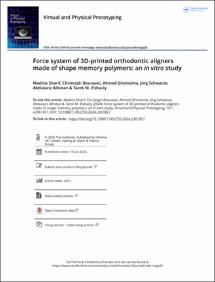Sharif, Madina; Bourauel, Christoph; Ghoneima, Ahmed; Schwarze, Jörg; Alhotan, Abdulaziz; Elshazly, Tarek M.: Force system of 3D-printed orthodontic aligners made of shape memory polymers : An in vitro study. In: Virtual and Physical Prototyping. 2024, vol. 19, iss. 1, e2361857, 1-11.
Online-Ausgabe in bonndoc: https://hdl.handle.net/20.500.11811/13282
Online-Ausgabe in bonndoc: https://hdl.handle.net/20.500.11811/13282
@article{handle:20.500.11811/13282,
author = {{Madina Sharif} and {Christoph Bourauel} and {Ahmed Ghoneima} and {Jörg Schwarze} and {Abdulaziz Alhotan} and {Tarek M. Elshazly}},
title = {Force system of 3D-printed orthodontic aligners made of shape memory polymers : An in vitro study},
publisher = {Taylor and Francis},
year = 2024,
month = jun,
journal = {Virtual and Physical Prototyping},
volume = 2024, vol. 19,
number = iss. 1, e2361857,
pages = 1--11,
note = {This study aimed to report forces and moments delivered by 3D-printed aligners. Tera Harz TC-85 resin and Zendura FLX (ZF) thermoformed sheets (0.76 mm) were used. Rectangular strip specimens (50 × 10 × 0.6 mm) were produced for a three-point bending test (3PB) at different temperatures. Full anatomical aligners were produced for 3D force measurements on different teeth and directions at 37 °C, using a custom-made device. ZF exhibited flexural forces between 1.7 and 2.3 N, while TC-85 from 0.3 N to 2.7 N, with temperature affecting TC-85 more significantly. At lower temperatures, TC-85 was stiffer than ZF, but at higher temperatures, it became less rigid. The 3D-force measurements indicated comparable values for both materials. Force ranged from 0.3–1.7 N and moment from 4.8–9.4 Nmm. The study concluded that TC-85 3D-printed aligners deliver biologically compatible forces for orthodontic movement and offer better control over thickness.},
url = {https://hdl.handle.net/20.500.11811/13282}
}
author = {{Madina Sharif} and {Christoph Bourauel} and {Ahmed Ghoneima} and {Jörg Schwarze} and {Abdulaziz Alhotan} and {Tarek M. Elshazly}},
title = {Force system of 3D-printed orthodontic aligners made of shape memory polymers : An in vitro study},
publisher = {Taylor and Francis},
year = 2024,
month = jun,
journal = {Virtual and Physical Prototyping},
volume = 2024, vol. 19,
number = iss. 1, e2361857,
pages = 1--11,
note = {This study aimed to report forces and moments delivered by 3D-printed aligners. Tera Harz TC-85 resin and Zendura FLX (ZF) thermoformed sheets (0.76 mm) were used. Rectangular strip specimens (50 × 10 × 0.6 mm) were produced for a three-point bending test (3PB) at different temperatures. Full anatomical aligners were produced for 3D force measurements on different teeth and directions at 37 °C, using a custom-made device. ZF exhibited flexural forces between 1.7 and 2.3 N, while TC-85 from 0.3 N to 2.7 N, with temperature affecting TC-85 more significantly. At lower temperatures, TC-85 was stiffer than ZF, but at higher temperatures, it became less rigid. The 3D-force measurements indicated comparable values for both materials. Force ranged from 0.3–1.7 N and moment from 4.8–9.4 Nmm. The study concluded that TC-85 3D-printed aligners deliver biologically compatible forces for orthodontic movement and offer better control over thickness.},
url = {https://hdl.handle.net/20.500.11811/13282}
}






